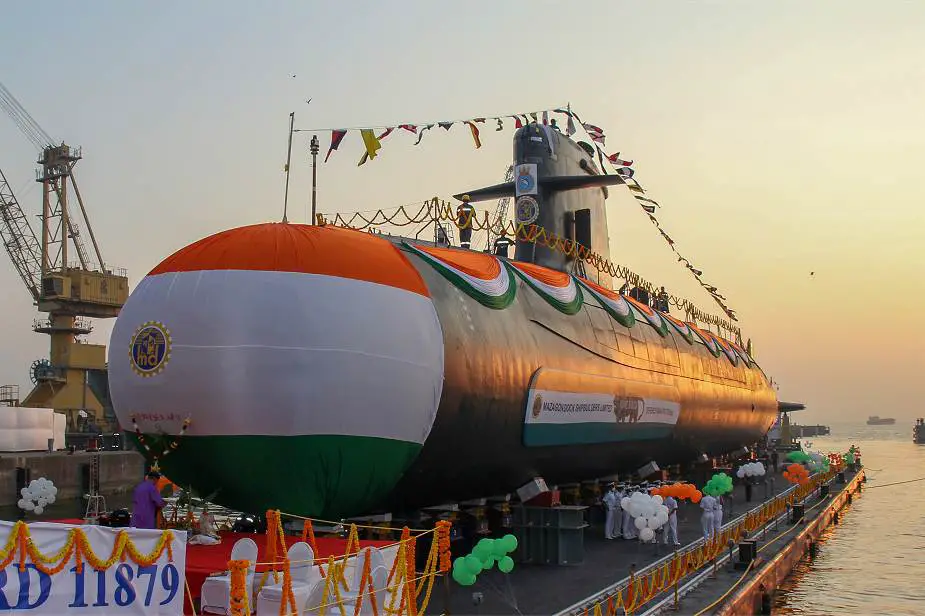According to a press release published on November 12, 2020, on November 12th 2020, INS Vagir was launched by Smt Vijaya Shripad Naik, wife of Shri Shripad Naik, Hon’ble Raksha Rajya Mantri. INS Vagir is the fifth P75 Scorpene® submarine entirely built by the Indian shipyard Mazagon Dock Shipbuilders Limited (MDL) based on years of technology transfer and partnership with Naval Group
Follow Navy Recognition on Google News at this link
 INS Vagir Scorpene-class submarine of the Indian Navy was launched on November 12, 2020. (Picture source Naval Group)
INS Vagir Scorpene-class submarine of the Indian Navy was launched on November 12, 2020. (Picture source Naval Group)
After recent commissioning of INS Khanderi in September 2019 and the launch of the INS Vela in May 2019, the Vagir, the fifth of the series of six Kalvari-class submarines ordered by India in 2005, to be launched.
This event highlights the success of the indigenous submarines construction program of the Government of India. These submarines have been completely built by Mazagon Dock Shipbuilders Limited (MDL) through a transfer of technology from Naval Group, in line with Indian Government’s “Make in India” policy. This series of six submarines are fitted with a number of equipment, built in India by qualified and highly trained industrial Micro, Small and Medium enterprises (MSMEs) which form the sound base of the Indian submarine building ecosystem.
“Naval Group is proud to be part of first of its kind P75 Kalvari program to deliver entirely ”Made in India” submarines to the Indian Navy. The P75 program is a major element of the strategic Indo-French partnership developed over the last decades. This launch, amidst Covid-19 challenges, represents a new milestone for this unique industrial program and illustrates the Aatmanirbharta (self-reliance) of Indian Navy and industry”, mentioned Alain Guillou, Senior EVP - International Development at Naval Group.
The Scorpène-class submarines are a class of diesel-electric attack submarines jointly developed by the French Company Naval Group (formerly DCNS) and the Spanish company Navantia. The Scorpène class of submarines has four subtypes including the CM-2000 conventional diesel-electric version, the AM-2000 air-independent propulsion (AIP) derivative, the downsized CA-2000 coastal submarine, and the enlarged S-BR for the Brazilian Navy, without AIP. The Scorpéne-class submarines are in service with Chile, Malaysia, India and Brazil. Over fourteen Scorpène submarines were sold by Naval Group internationally.
Citing Forecast International, The Scorpène hull design traces its lineage to the proposed diesel-electric version of the nuclear-powered Amethyste-class attack submarines. This design has been downsized to eliminate the size penalties that are automatically associated with nuclear power. The hull form itself is a derivative of the hydro-dynamically efficient Albacore design, with an extended parallel mid-ships section and rounded bow. The stern form is elongated and features fin-mounted hydroplanes and "+" shaped tailplanes.
Internally, the layout is very conventional, with two decks. The accommodations are on the upper deck, with the ship's diesel and batteries situated on the lower deck. The torpedo tubes are forward, firing out through the bow, with the sonar arrays in the chin position under the tubes. The ship has accommodations for 31 men, with a standard watch team of nine. The control room and the living quarters are mounted on an elastically supported and acoustically isolated floating platform. All living and operational areas are air-conditioned. The submarine also has space for six additional fold-down bunks for a special operations crew.
The Scorpène -class submarine has two diesel generation sets providing 1,250kW of power. At the top of the hull immediately above the diesel generator sets is a Dutch Breach machinery shipping hatch. The submarine has an elastically supported 2,900kW electronic engine.
The Scorpène submarine can carry 18 torpedoes and missiles or 30 mines. It is equipped with six bow-located 21in torpedo tubes providing salvo launch capability. Positive discharge launching is by an air turbine pump. It can launch anti-ship and anti-submarine torpedoes, as well as anti-surface missiles. The handling and loading of weapons are automated.



